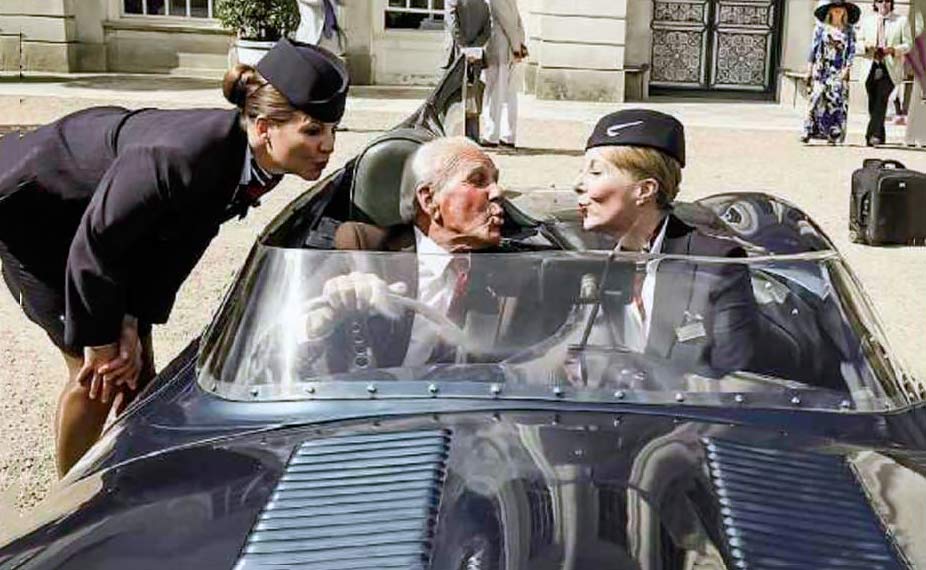
Le Mans D-Types. On road and track in the legendary Le Mans-winning trio of 1957 Jaguars. Winners! Five Jaguar D-types – including the 1957 Le Mans 1-2-3 finishers – on a two-day road trip? Mark Dixon draws the short straw. Photography Matthew Howell, Chris Brown and Mike Dodd.
LE MANS D-TYPES Jaguar’s all-conquering 1957 trio reunited – on road and track…
For drivers approaching the A5/A43 Towcester roundabout in Northamptonshire, not far from Silverstone, it must have been an unforgettable sight. And the sound must have been equally memorable. Five Jaguar D-types, blasting away from the roundabout and onto the dual carriageway. Genuine race cars on the road.

But only the true cognoscente – or, if you prefer, D-type anorak – will have recognised the significance of those cars. Between them, these five account for all four of the long-nose D-types still in Europe today; all three of the Ecurie Ecosse long-nose cars; and the Ds that finished one-two-three at Le Mans in 1957.
It’s to celebrate that final, stunning achievement in 1957 that we’re making a D-type pilgrimage today. We’re driving from the new spiritual home of classic Jaguars – the company’s Classic Works facility at Ryton, on the southern outskirts of Coventry – to the Concours of Elegance at Hampton Court. And we’ll be calling in at a few interesting places along the way.
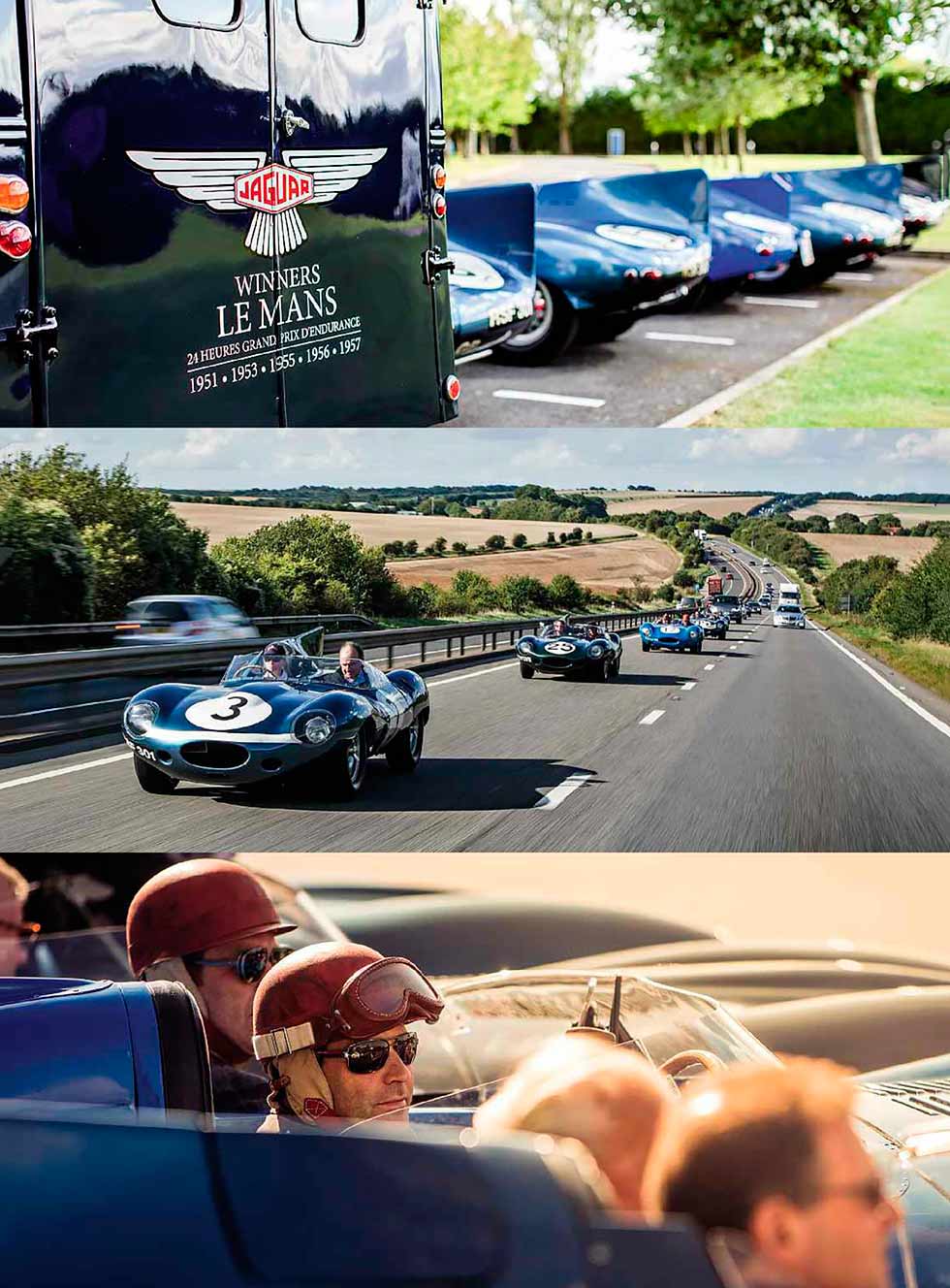
THURSDAY DAWNS bright and clear (thankfully) as the D-types assemble outside Jaguar Classic Works. This building has been open for only a few months and still has that ‘brand new’ smell. The site itself has history, however, for until 2007 the old Peugeot factory stood here, a relic of World War Two, when the Rootes Group built a ‘shadow’ factory well away from Coventry city centre to keep it safe (relatively speaking) from German bombs. Engines for Bristol Blenheims were once assembled where Jaguar’s XK straight-sixes are now rebuilt.
Inside Classic Works, there’s human as well as mechanical history, too. Jaguar has wheeled out some of its metaphorical big guns to mark today’s occasion. Mingling with the car owners and partners drinking coffee in the lobby are legendary test driver Norman Dewis, who celebrated his 97th birthday just a few days earlier; ’50s Le Mans mechanic Ron Gaudion (more about him later); and more recent luminaries such as Jaguar’s director of design Ian Callum.
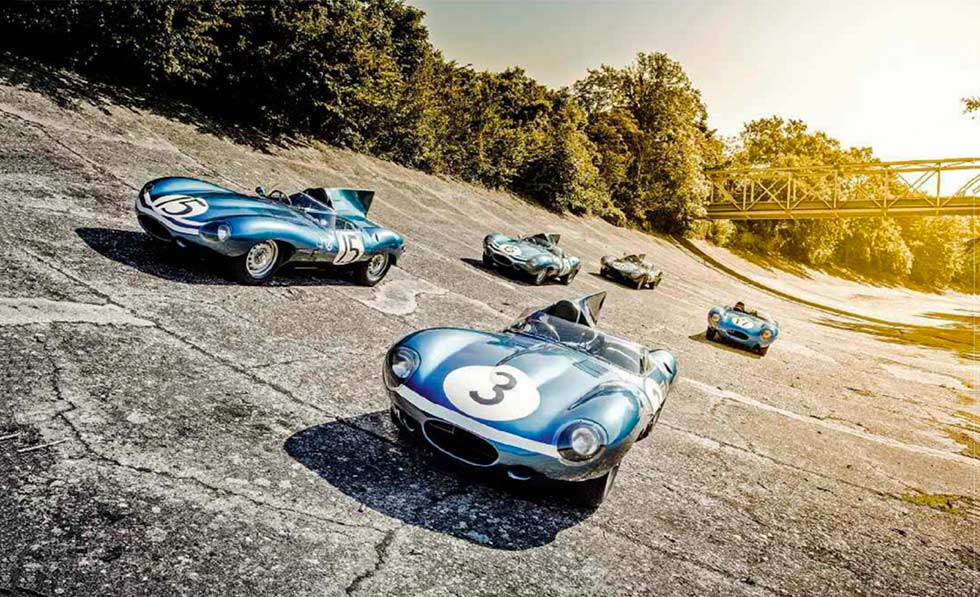
Engaging and amusing as ever, Ian lets slip that he’s just bought a childhood dream car: a 2.3-litre Vauxhall Chevette HS. In silver with red stripe, natch.
But the clock is ticking. We have other places to visit, promises to keep, and miles to go before we sleep. Lined up in the car park with noses facing out, ready to rumble, are the five D-types.
Three of them are Ecurie Ecosse machines in the team’s trademark metallic blue, with white stripes across the nose. They are, respectively, chassis XKD 606 (one stripe), the 1957 Le Mans winner that’s now owned by the Louwman Museum; XKD 603 (two stripes), second at Le Mans in ’1957 and belonging to Clive Beecham; and XKD 504 (three stripes), which is still being raced today, in the hands of owner Christian Gläsel.

Then we have the Jaguar Daimler Heritage Trust’s XKD 605, in British Racing Green, winner of the 1956 Reims 12 Hours. And last but very much not least is XKD 513, painted the vivid French Racing Blue in which it finished third at Le Mans in 1957 behind the two Ecurie Ecosse D-types. It’s now owned by Austrian enthusiasts Jörg and Günther Holleis.
Oh, and there’s another Jaguar works team vehicle: Clive Beecham’s 1950 Bedford 30cwt lorry that he’s had restored as an exact replica of the works’ parts van. The Bedford will be trundling its way to Hampton Court, too, albeit at a rather more sedate pace.
For the first leg of our journey, Drive-my’s man is deputed to ride with Christian Gläsel in XKD 504 (three stripes). Carefully opening the light-as-paper alloy door, I search out the most rigid-looking parts of the cockpit surround for my hands to lower myself inside the bathtub-like passenger compartment. It’s certainly cosy in here but not too uncomfortable, once you’ve acclimatised to the semi-foetal position required.
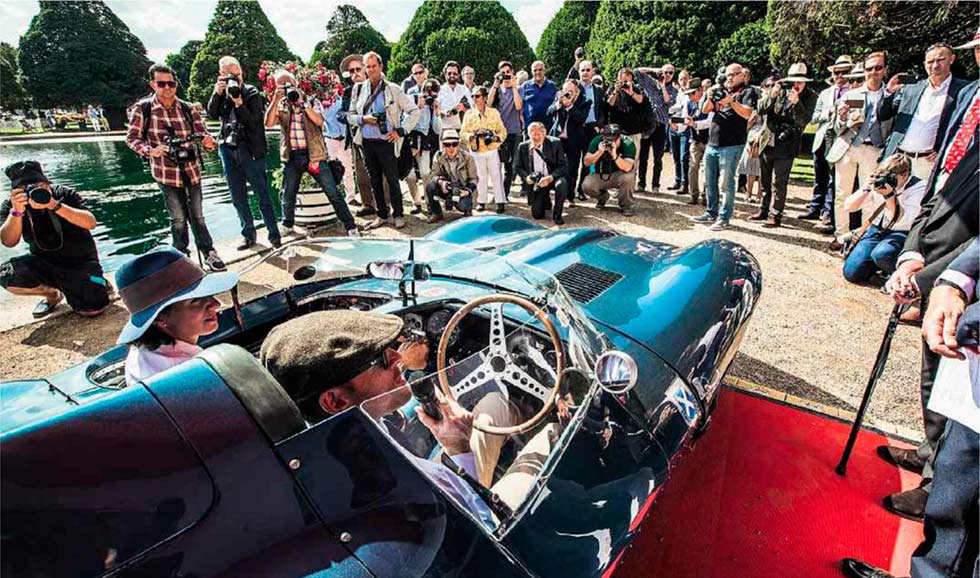
Christian has owned this car since 2013. ‘It’s a car I’ve coveted since I was a child: cooler than a Ferrari and such an icon because of its dominance in the mid-50s. While I’m a little nervous because it’s so historically important, I do race it and will continue to do so in selected events for the foreseeable future.’
Racing instincts to the fore, Christian fires up 504 and noses the car out behind the new Discovery that will be filming the convoy as we head to our first destination: Sir William Lyons’ former home, Wappenbury Hall. We’re not even out of the car park and I can tell that this car is something of a handful in its competition state of tune. The clutch is either in or out and, with ‘hot’ spark plugs installed, the engine is a bit fluffy at low revs.
But what a noise! At idle it sizzles like a countrysized slice of bacon in the world’s largest frying pan. When Christian gives it some right foot, it emits a raw, animalistic blare that is intensely exciting. As former D-type mechanic Ron Gaudion describes the sensation later: ‘It sets up a tingle in your stomach that runs right down to your feet.’
Just a few minutes’ rumbling through the Warwickshire lanes brings us to Wappenbury Hall (the location for our photoshoot with Sir William’s Mk10 saloon). This Victorian pile is still for sale at an asking price of £3.5 million but is reputedly under offer, so move fast if you want to take advantage of the ‘extensive garaging’ that is an added attraction at the Jaguar enthusiast’s ultimate pad.
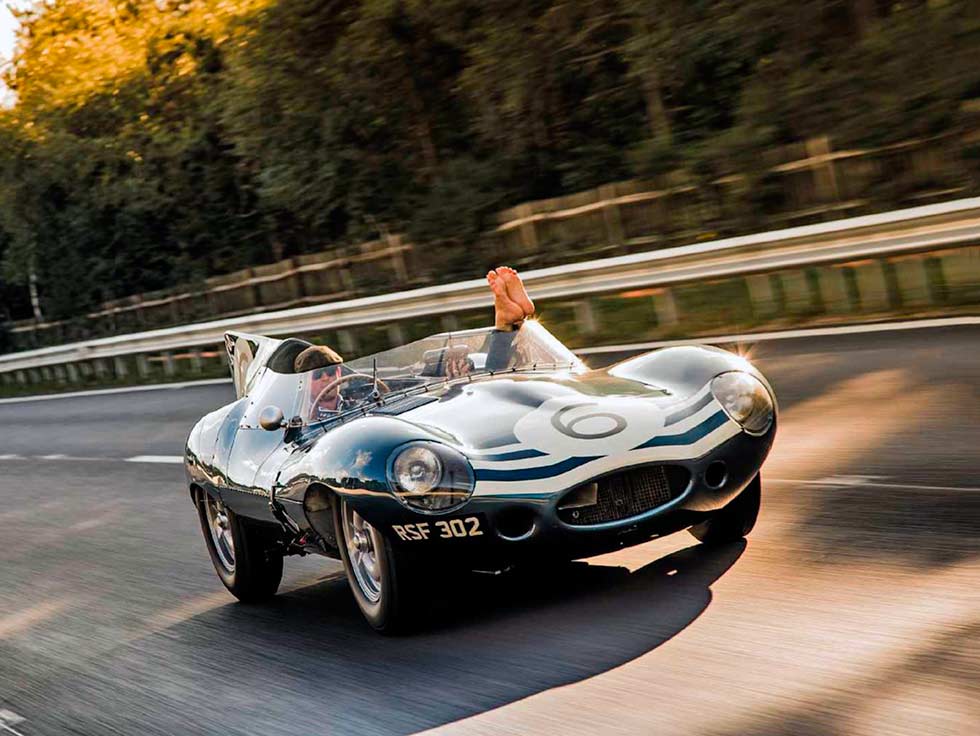
The cars line up again for the obligatory photocall, and peace descends briefly as engines are switched off and passengers uncurl their legs. With its immaculately tended, slightly garish herbaceous borders and warm red bricks, the Hall makes a strikingly 1950s period backdrop for the D-types, as though they’re waiting for Sir William himself to step out and give his blessing for the convoy of works-backed racers, en route to La Sarthe 60 years ago.
And it was this concept of driving the works cars from the Coventry factory all the way to Le Mans ahead of the race – something that seems so unthinkable today – that inspired D-type owner Clive Beecham to initiate the tour. Fortunately, Jaguar Land Rover, the Royal Automobile Club and the Concours of Elegance were all keen to help out.
‘I realised that 2017 was the 60th anniversary of a historic victory, and something needed to be planned to celebrate it,’ he says. ‘It seemed to me that we had to do something. It was too important to overlook.’
Our chat is cut short by the signal for ‘Gentlemen, to your cars!’ – gentlemen and one lady, that is, for Quirina ‘Queenie’ Louwman, daughter of museum founder Evert (who’s also here), is driving 1957’s winning car with her English husband James Wood. Queenie and James are both highly experienced race drivers; have a guess how many Mille Miglias Queenie has done. Would you imagine 19? Yes, one-nine!

But Christian and I are still leading the pack as we snap, crackle and pop out of the Hall gates and set course for Silverstone, where there’s the promise of a couple of hot laps. D-types were frequent visitors to the circuit back in the day; indeed, their first public outing in 1954 was to have been at Silverstone’s International Trophy Meeting, only for the two works entries to be pulled at the last minute in the frantic dash to be ready for Le Mans.
The old A5 trunk road has been largely superseded by the M1 motorway that shadows it, and which opened just two years after the D-type’s one-two-three at Le Mans, but its long straights, bounded for mile after mile by trees and hedges, are perfect for evoking 1950s high-speed motoring. At least, they would be, if the traffic permitted. These cars just feel so constrained at a legal limit of 60mph; they are geared to do another ton or so beyond that, and you can be damn sure that Jaguar’s works drivers didn’t worry too much about sticking to the rules when they were dashing to make the ferry or the airport, six decades ago.
Different times, though… For amusement’s sake, I ask Christian to slow right down and then gun XKD 504 through the lower gears. He’s more than happy to oblige. Whooo-ah! The exhausts erupt in a savage, brassy blare, the nose rises like a speedboat’s prow, and the JLR camera car that was a couple of hundred yards in front is suddenly being reeled in as though we’re in a movie on fast-forward. Christian barely has time to get into third gear before he has to back off. It’s just incredible – we’re in a 60-year-old Jaguar, and it’s accelerating like a modern supercar!
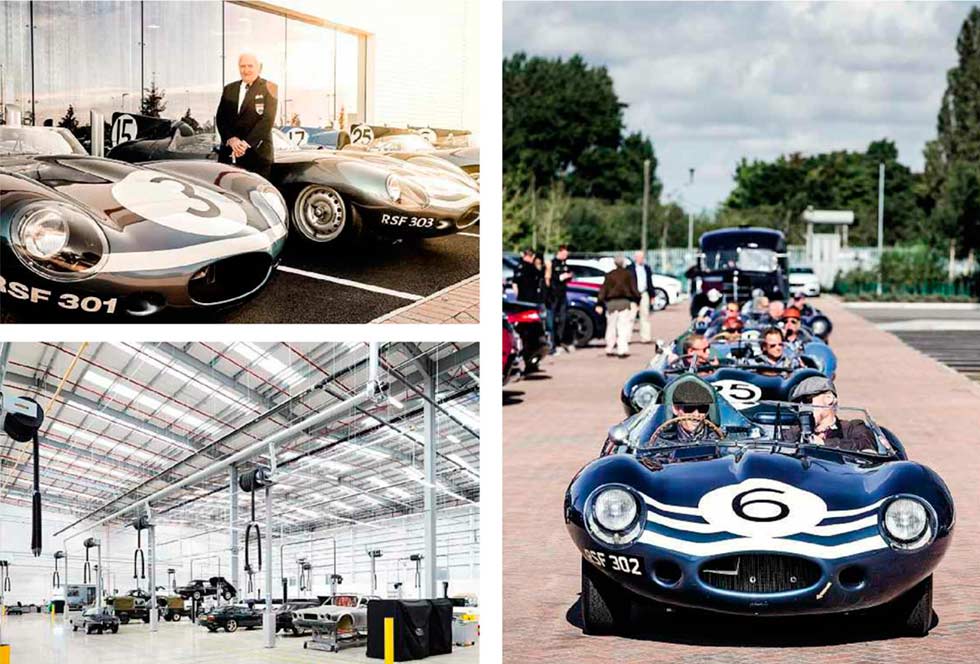
And then it gets better, because we’ve arrived at the roundabout where we turn right onto the A43 dual carriageway, and by some miracle all five D-types have a clear path together away from the traffic lights that control our exit. We’re still in the lead and, as Christian stands on the loud pedal, our fellow Tourists respond just as enthusiastically and all of a sudden we’re on the opening lap at Le Mans on 22 June 1957…
OK, maybe that’s stretching the imagination just a little too far, but to be a part of this convoy, to witness from the hot seat these five cars hammering along a fast dual carriageway towards Silverstone, carving past trucks and vans as if they are standing still, is almost heart-stopping in its emotional charge.
And then it gets even better than that. Much better. After we’ve arrived at the circuit and the marshals have been cajoled to let us have a few minutes of precious track time for our cover shot, Clive Beecham tosses me the keys to XKD 603 (two stripes, remember) and suggests I lead the formation. To put that act of generosity into context, consider that the 1956 Le Mans-winning D-type, XKD 501, another Ecurie Ecosse car, sold at auction for $21.78 million last year.
Fortunately, Clive’s car is rather more tractable than Christian’s at the speeds required for photography; and I know from having piloted Jaguar’s prototype D-type, XKC 401, from Coventry to Norman Dewis’s home in Shropshire for Drive-My back in 2014 that there’s nothing to fear – other than running into the back of the camera car, of course.
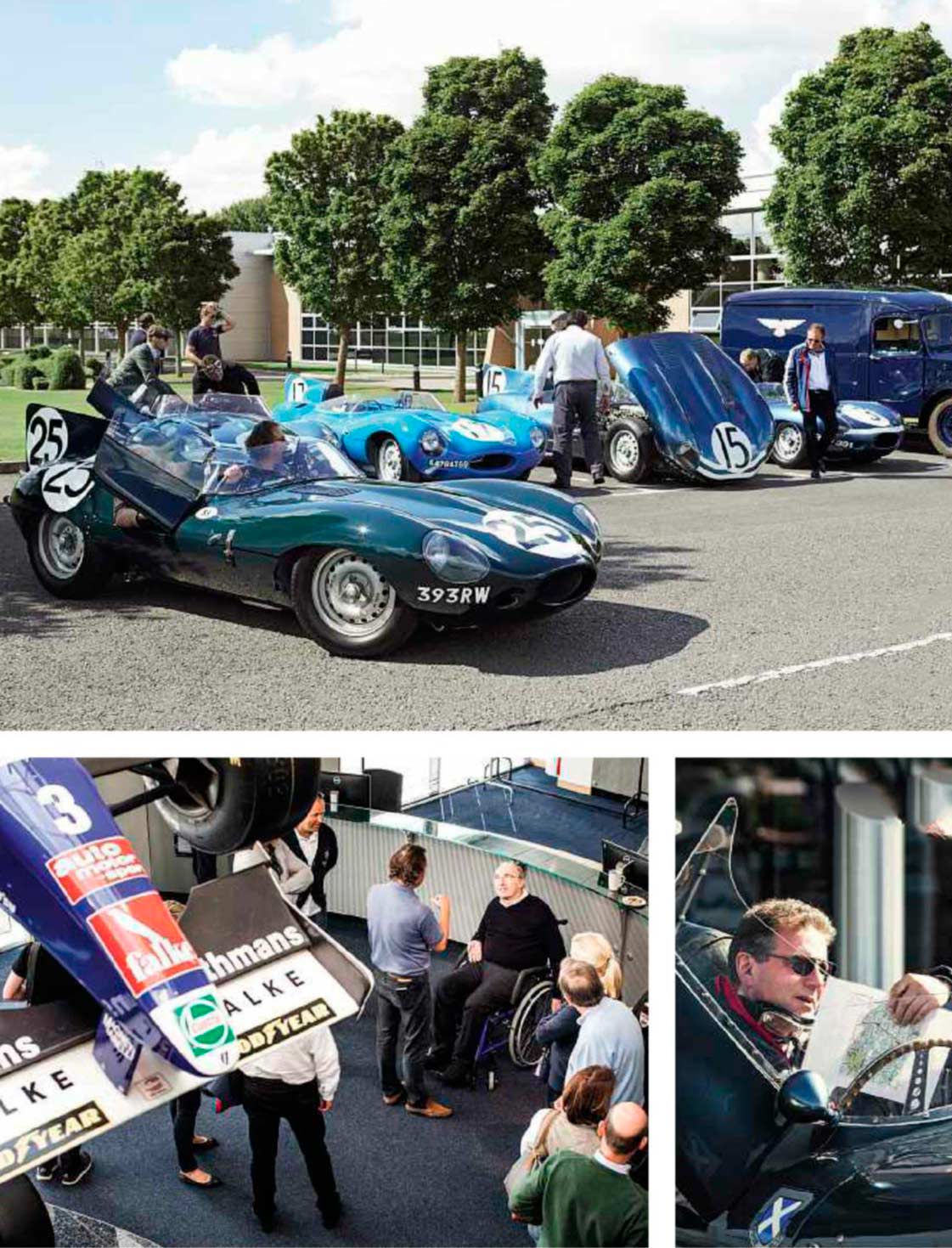
That’s the glory of the D-type. It’s a full-house 1950s racing car, the apogee of motor sport technology in its day, and yet it’s as easy to handle as an MG or Triumph. I’m not kidding. The steering is beautifully light, the gearchange positive and mechanical in feel, the brakes superb, and the ride more supple than any massmarket sports car’s. It is just unbelievably good.
Pushing that heavily cranked-forward gearlever into first, I ease up the clutch and start rolling behind Matt Howell’s camera car, shifting up a couple of gears as we move into our allotted positions. As soon as Matt has nailed the shot, the camera car pulls off, and suddenly there’s a chance to hustle the Jaguar rather more quickly. We’re a long away from touching 170mph down the Mulsanne Straight, of course, but as I double-declutch, downshift and feel the car roll mildly through Brooklands and Luffield corners, straight-six yowling, I feel like I’m king of the world.
A full 60 years ago, this car finished second at Le Mans in the hands of Ninian Sanderson and Jock Lawrence. Incredibly, five of the top six cars that year were D-types, the sole interloper being a Ferrari 315 S that came in fifth. What was really remarkable, however, was the performance of the sixth-placed D-type, driven by Hamilton and Gregory. Having dropped down as far as 20th due to the exhaust burning away part of the cockpit floor – really! – they clawed their way back to sixth by driving the car absolutely flat-out for 15 hours. You could do that in a ‘D’ and get away with it.
Heroics like that won’t be needed today, but we do need to push onto our penultimate destination: Williams Advanced Engineering near Wantage in Oxfordshire, the home of Williams F1. It’s mostly dual carriageway to get there, with a few miles of M40 motorway, and for the first time we get a bit of rain. I’m hunched in the passenger seat of Clive’s D-type with the raindrops stinging my face like shotgun pellets, and you know what? It’s just fantastic.
D-types safely arrived at Williams – and the Bedford van has manfully made it here, too – there’s time for a bite of lunch and a whistlestop tour of the F1 museum and the workshops (the bits that aren’t top-secret, anyway). But the highlight of our visit is when Frank Williams himself appears to greet us and say hello. Perhaps he has a special affinity with Jaguars because, in a way, he owes everything to the marque: it was a teenage ride in a friend’s XK150 during the late-50s that got him hooked on cars.
An unexpected postscript… Later, after we’ve saddled up and are roaring out of the main gates, there’s Frank, in his wheelchair on the pavement, grinning broadly and waving at each car as it passes. It’s a hugely poignant moment and to say that we’re touched would be an understatement.
The rest of the journey south, to the RAC Country Club at Woodcote Park, in Surrey, where the cars will rest up overnight, is eventful only for the amount of traffic we encounter; Christian Gläsel’s XKD 504 runs out of fuel literally yards from its parking space. But everyone has made it. Yes, there has been the odd glitch with rough running along the way, but nothing that a bit of fettling wasn’t able to cure. Not bad for a clutch of 60-year-old racing cars.
This is where I have to depart the tour and head back to home and reality. Tomorrow, the D-types will head for Brooklands and its famous banking, in a nod to the Monza 500 in which the trio of Ecurie Ecosse D-types participated just a week after the 1957 Le Mans. From there, it’s only a short blat to Hampton Court, and most of the cars will then go on to Goodwood for the Revival.
Three years ago, I asked Norman Dewis whether he would have made any changes to the D-type, with the benefit of six decades of hindsight. ‘Not really,’ he replied. ‘It was just right, from the beginning.’ And that’s about the best seven-word description of a D-type it’s possible to make.
‘Mingling with the car owners drinking coffee is legendary test driver Norman Dewis’
‘The exhausts erupt in a brassy blare and the car’s nose rises like a speedboat’s’
MAN WITH A PLAN
Ron Gaudion came to the UK looking for work – and found himself pit crewing at Le Mans in 1955, ’56 and ’57… Words Mark Dixon.
LE MANS D-TYPES
‘After Le Mans in 1955 we felt good, but we didn’t celebrate because of the accident. In ’56 we had a few beers, having beaten Moss and Collins in the Aston Martin into second place. But in ’57, when we came first and second, David Murray was so pleased that he laid on a wonderful dinner in one of the hotels in Le Mans. It was fantastic.’
In his soft Aussie drawl, Ron Gaudion is recalling his time as a pit mechanic at Le Mans with, firstly, Jaguar in 1955, and then with the Ecurie Ecosse team in 1956 and ’1957. Ron who? Chances are you will never have heard of him, but this dyed-in-the-wool Australian was the first employee taken on by Jaguar to build the production D-types, and he looked after them during their competition heyday of 1955-1957. Ron moved back to Australia in 1958 to take up a job with BP and has been under the radar ever since. But now he’s making a rare visit to the UK and catching up with old mates such as Norman Dewis, with whom he worked on the D-type programme.
‘I landed in England in January 1954 and got a job for ten months in Manchester,’ he recalls. ‘But I’d come over to further my knowledge of the automotive industry, so in January 1955 I drove to Birmingham and went round Norton, Triumph and Beezer [BSA]. No-one was hiring. My last visit was to Jaguar on a Monday morning. No luck there, either.’
Fortunately for Ron, it turned out that, while the personnel manager at Jaguar had completely forgotten about the new sports-racing car project that was about to begin, the labour exchange in Coventry hadn’t. Two days later, he officially started work at Jaguar as the first employee drafted in to help translate Malcolm Sayer’s D-type sketches and blueprints into metal.
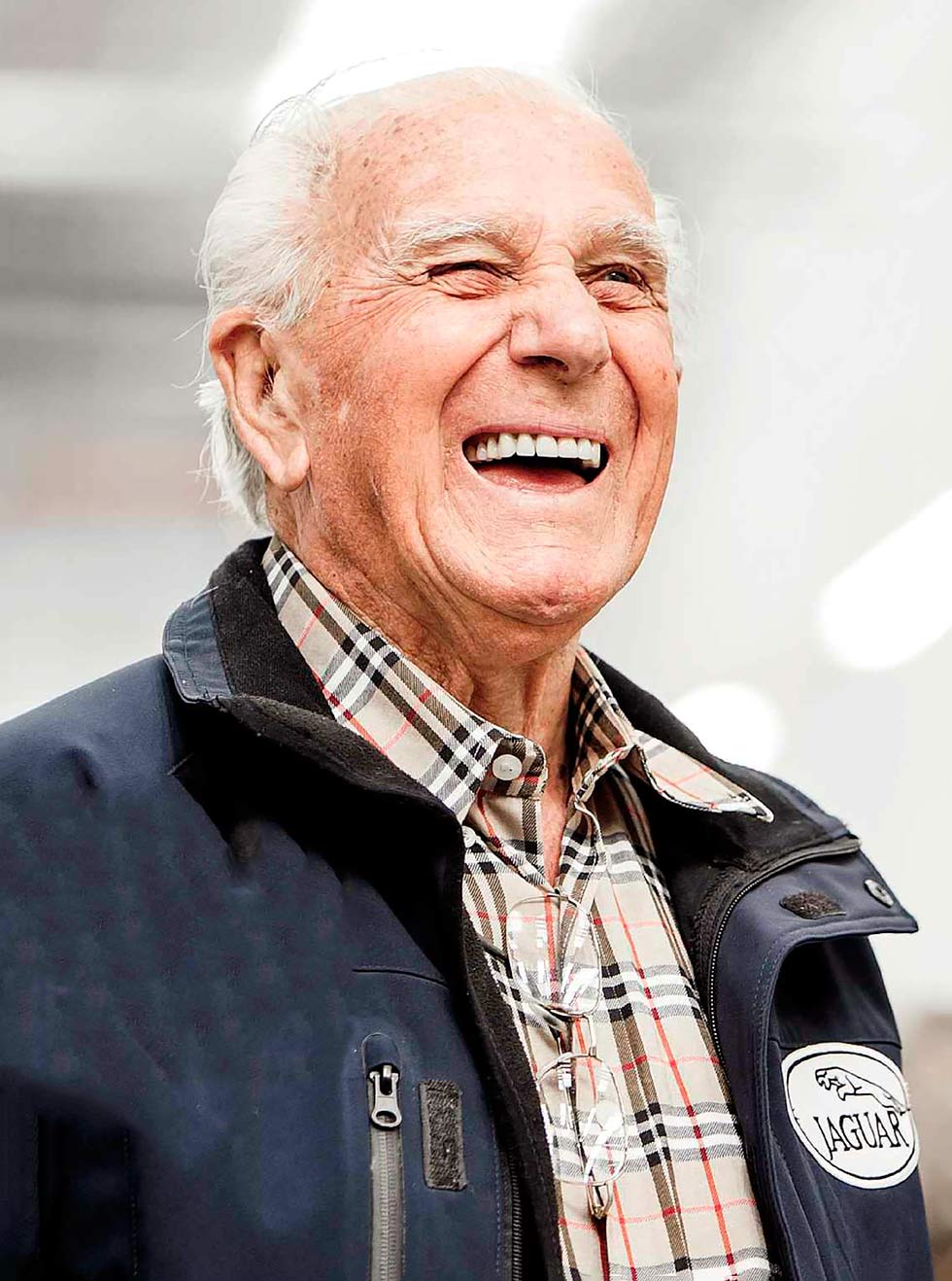
‘At eight o’clock on Wednesday I walked between the lines of MkVIIs and XK140s and into the Experimental Department. The superintendent, Phil Weaver, told me about this completely new concept of the “monocoque” and got me making patterns in eighth-inch steel plate for the front subframe.’
Initially Ron was employed as a toolmaker but, as the deadline for Le Mans drew nearer, he was asked to help assemble a couple of works racing cars in the Competition Department. Then, because he already had a passport – a rarity for most Brits – he was invited to accompany the Jaguar team to Le Mans…
It turned out to be a mixed blessing. Ron was standing on the pit wall when Lance Macklin’s ’Healey and the Mercedes-Benz 300 SLR of Pierre Levegh collided, sending the Mercedes cartwheeling into the crowd. More than 80 people died and up to 200 were injured. Ron himself has terrible memories of the crash.
‘There were two guys standing just below me, a gendarme and a plombeur, who was there to check the lead seals on the cars, and they were literally cut in half by the ’Healey. Next day, we were having breakfast behind the pits, and someone noticed something lying in the paddock. It was the hair and half the face of a lady who’d been killed by the radiator of the Healey, which had been thrown right over the pits.’
Fortunately, 1956’s Le Mans was a much happier time for Ron. He had recently joined David Murray’s Ecurie Ecosse team, which was entering a solitary D-type for the 24 Hours. It won the race, without drama of any kind. ‘We were lucky to win against all that opposition,’ he says simply.
For 1957’s event, Ron was chosen to deliver a 3.8-litre fuel-injected D-type to Le Mans. ‘I was tailend Charlie in a convoy of four D-types, and as we were driving down to Brighton I got separated from the car in front by a frustrated farmer who shot out of a gateway in his tractor. When he turned off, I had to catch up because I didn’t know where the airfield was for the Silver City Freighter that was taking the cars to France! The road was a little bit damp so I was getting wheelspin in top gear – and I later calculated from the revcounter that I’d been pulling 151-152mph. It was the fastest I’d ever been in a D-type.’
Life during the race itself was very full-on. ‘We’d be up for about 36 hours, from 8am on Saturday, and by the time we’d packed up after the race and had a few gargles it would be near enough Monday morning. ‘After the 1957 event we loaded the transporters and drove the cars straight to Monza, where we were racing against the Indianapolis cars. Being an oval, Monza suited them and they were running bigger wheels, but we were limited to 160mph to avoid throwing tyre treads. The Yanks were rebuilding their suspensions and changing gearboxes in the breaks between the three heats, but our cars had just come straight from Le Mans and we didn’t touch them other than for doing the usual checks on brakes and for overrevving, which would mean taking a cylinder head off.
‘We finished fourth, fifth and sixth behind the Americans, but if there hadn’t been three heats over the 500 miles, if it had just been a case of going the full distance, I think we would have tossed them. The engines were very reliable. We rarely had to do much more than top up with oil during driver changes – and sometimes we didn’t even have to do that.’
